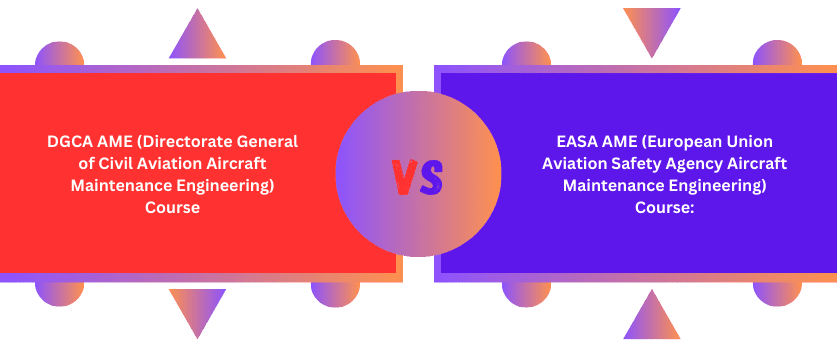DGCA AME (Directorate General of Civil Aviation Aircraft Maintenance Engineering) Course
Regulatory Authority
DGCA AME courses are regulated by the Directorate General of Civil Aviation in India. DGCA sets the standards, curriculum, and examinations for AME training.
Approval for Aircraft Categories
DGCA AME courses are specific to aircraft registered in India. The training covers the maintenance, repair, and inspection of aircraft types approved by DGCA.
Curriculum and Duration
The curriculum for DGCA AME courses is designed in accordance with DGCA regulations. The duration of the course is typically three to four years, including both theoretical and practical training.
License Issued
Upon successful completion of the DGCA AME course, candidates are eligible to apply for an AME license from DGCA, allowing them to perform maintenance on aircraft registered in India.
EASA AME (European Union Aviation Safety Agency Aircraft Maintenance Engineering) Course:
Regulatory Authority
EASA AME courses are regulated by the European Union Aviation Safety Agency, which sets the standards for aviation safety and maintenance across European Union member states.
Approval for Aircraft Categories
EASA AME courses are designed to cover a broader spectrum of aircraft types, including those registered in European countries. The training is recognized across EASA member states.
Curriculum and Duration
The curriculum for EASA AME courses adheres to EASA regulations. The duration of the course is typically around two to three years, with a combination of theoretical knowledge and practical training.
License Issued
Upon successful completion of the EASA AME course, candidates are eligible to apply for an EASA Part-66 license, which is recognized across EASA member states. This allows them to work on a wide range of aircraft within the EASA regulatory framework.
Differences Between DGCA AME and EASA AME:
Geographical Scope
DGCA AME courses are focused on aircraft registered in India, while EASA AME courses have a broader geographical scope, covering aircraft registered in EASA member states.
Regulatory Authority
DGCA AME is regulated by the Indian aviation authority, DGCA, whereas EASA AME is regulated by the European Union Aviation Safety Agency.
Recognition and Acceptance
EASA AME courses have international recognition, and the EASA Part-66 license is accepted in EASA member states. DGCA AME courses are primarily recognized within India.
Aircraft Categories
DGCA AME courses cover aircraft types approved by DGCA for operation in India. EASA AME courses cover a wider range of aircraft types in accordance with EASA regulations.
Duration of the Course
The duration of DGCA AME courses is typically longer (three to four years) compared to EASA AME courses, which are generally around two to three years.
Both DGCA AME and EASA AME courses provide comprehensive training in aircraft maintenance engineering, but the key differences lie in their regulatory frameworks, geographical scope, and international recognition. Individuals pursuing a career as an Aircraft Maintenance Engineer should choose the course that aligns with their career goals and the region in which they plan to work.
FAQs on DGCA AME vs. EASA AME Courses
Q1. What is the DGCA AME course?
A. The DGCA AME (Directorate General of Civil Aviation Aircraft Maintenance Engineering) course is an aircraft maintenance engineering program regulated by the Indian Directorate General of Civil Aviation.
Q2. What does EASA AME stand for?
A. EASA AME refers to the European Union Aviation Safety Agency Aircraft Maintenance Engineering course, regulated by the European Union for aviation safety and maintenance.
Q3. What is the primary difference between DGCA AME and EASA AME courses?
A. The key difference lies in their regulatory authority and geographical scope. DGCA AME is specific to India, while EASA AME has broader recognition across European Union member states.
Q4. Which aircraft categories do DGCA AME courses cover?
A. DGCA AME courses cover aircraft types approved by the Directorate General of Civil Aviation for operation in India.
Q5. In which geographical region is DGCA AME recognized?
A. DGCA AME is primarily recognized within India.
Q6. What is the significance of the EASA AME Part-66 license?
A. The EASA Part-66 license, obtained after completing EASA AME training, is recognized across European Union member states, allowing professionals to work on a wide range of aircraft.
Q7. Do DGCA AME courses have international recognition?
A. DGCA AME courses are primarily recognized within India and may not have the same level of international recognition as EASA AME courses.
Q8. How long does it typically take to complete DGCA AME and EASA AME courses?
A. DGCA AME courses generally have a longer duration, around three to four years, while EASA AME courses are typically around two to three years.
Q9. Can individuals with EASA Part-66 licenses work on aircraft in India?
A. Yes, individuals with EASA Part-66 licenses can work on aircraft in India, but they may need to comply with additional regulatory requirements.
Q10. Which course should aspiring aircraft maintenance engineers choose – DGCA AME or EASA AME?
A. The choice depends on individual career goals and the region in which one plans to work. If targeting India, DGCA AME may be more suitable, while EASA AME offers broader international opportunities within the European Union.
To become an aircraft maintenance engineer you may could join AME engineering through AME COMMON ENTRANCE EXAM (AME CEE) this examination you may join AME engineering approved by DGCA, EASA or UGC.


